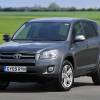
Complete peace of mind for less
• Cheaper than AA Price Promise or your money back^
• We get to most breakdowns in 60 mins or less
• Our patrols fix 4/5 breakdowns on the spot

BY JONATHAN CROUCH
Introduction
Reliable, comfortable, if largely unexciting, family transport doesn't come much better than this. Toyota's Carina E is around in solid numbers on the secondhand market and it's a British-built car you can buy with real confidence.
The `E` stands for `Europe`, identifying a Toyota that was supposedly specifically designed for the European market (though it didn't look any different from those sold on the other side of the world). This was the car that launched Toyota's presence in the UK in 1992, built at Burnaston in Derbyshire and powered mostly by engines from Deeside in North Wales.
Models
Models Covered:
4-door saloon, 5dr liftback, estate 1.6, 1.8, 2.0, 2.0 diesel, 2.0 turbo diesel [X, XL, GS, GL, GLi, S, CD, CDX, Executive, GTi, GSD, GLD, TD GS, TD GL]
History
The Carina E was the car charged with substantially increasing Toyota's UK market share, largely through infiltration into fleets. And it was largely successful in doing so. The first car was produced on December 16th 1992 and, by October 1994, 100,000 examples had come off the line, making this easily Toyota's best-selling model.
Originally, just three engines were available - a 1.6-litre and 2.0-litre petrol units and a 2.0-litre normally aspirated diesel. A 171bhp 2.0-litre GTi, with power from the Celica sports coupe, followed shortly afterwards, together with a couple of estate variants.
In 1994, there was a mild revamp, with the inclusion of a driver's airbag as standard across the range, together with an alarm/immobiliser on most models. A 1.8-litre 'lean burn' engine option arrived in 1985 and, in 1996, Toyota introduced a facelift with twin airbags and ABS across the range and offered a turbo diesel variant for the first time. This range was replaced in 1997 by the all-new Avensis line-up.
What You Get
Since the car was launched, there's been plenty of hot new competition in the family sector. However, the Toyota's build quality, low depreciation and rear seat cabin space still makes it a force to be reckoned with.
Toyota's response to the safety trend was tardy - Carina Es didn't get a driver's airbag (even as an option) until 1994 and dual 'bags and ABS weren't standard until 1996. Apart from that (and the best-forgotten normally aspirated diesel), there isn't much to criticise.
There's certainly no shortage of choice; three bodystyles (saloon, five-door and estate), at least seven different trim levels and a selection of four different 16-valve DOHC petrol engines await you. If you can afford a recent model, try and find one with Toyota's astonishingly frugal 1.8-litre lean burn petrol engine.
The more you drive a Carina, the more you realise how carefully thought out Toyota's thrust into the medium range marketplace has been. Though the styling reminds you of at least four other models in the class, the end result is not unappealing.
What You Pay
Please fill in the form here for an exact up-to-date information.
What to Look For
Very little goes wrong. The Xi and XLi trimmed cars are good value and the GL variants have lots of equipment.
The estates aren't all that spacious and the non-turbo diesels not all that economical. Don't worry about uninspiring GTi models either (they're rarer than hens' teeth anyway).
Replacement Parts
(Based on a 1.6-litre Carina E - ex Vat) Good quality but slightly pricier than the mainstream competition. A new clutch will cost you about £90. Front shock absorbers are about £50 and rears around £80. An exchange alternator is about £240, a radiator about £150 and a replacement windscreen close to £140. A tail lamp is about £60 and a nearside front wing about £140. A catalyst is about £700.
On the Road
Foolproof is the word that springs to mind. Carinas have never been favourites with driving enthusiasts - and this one is no different. If, however, you want solid, well equipped, reliable family transport, then you won't care about that.
All the engines offered (apart from the diesel) are willing performers. The 1.8-litre lean burn unit combines ready acceleration (rest to 60 in 11.7 seconds on the way to 118mph) with impressive economy; at least 35mpg around town and between 45-50mpg at cruising speeds.
Most cars you'll come across will have electric front windows, sunroof, power steering, stereo, rev counter and more. Basically, it depends upon your choice of trim - X, XL, GS, CD or GL. Either way, there are more creature comforts, pound for pound, than with most of the competition.
Overall
A sound family secondhand buy. It's almost impossible to go wrong buying a Carina E. Peace of mind starts here.






![Ford Mondeo MK4 [CD931] (2019 - 2022) used car review](https://d1gymyavdvyjgt.cloudfront.net/drive/images/made/drive/images/remote/https_d2yv47kjv2gmpz.cloudfront.net/filestore/5/8/1/1_beba92e409a45f7/1d6aa9c7f096d5d290c4669d8439b309/1185_6f49494a28a902a_100_100_70_c1_c_c.jpg)
